The word ‘macropod’ means ‘big foot’. However unlike the mythical Big Foot of North America, there are many places in south-east Queensland (SEQ) where you’ll have no problems seeing one of our home-grown species, better known as kangaroos and wallabies.
With around 60 species in Australia and New Guinea, macropods are one of the world’s most successful radiations of mammalian herbivores. They occupy almost all available terrestrial habitats including rainforests, deserts, rocky outcrops and open forests. They have developed unique habits from living in trees (eg tree-kangaroos) to burrowing underground (eg hare-wallabies). Detailed here are the nine species of macropod found in SEQ.
Agile Wallaby (Macropus agilis)
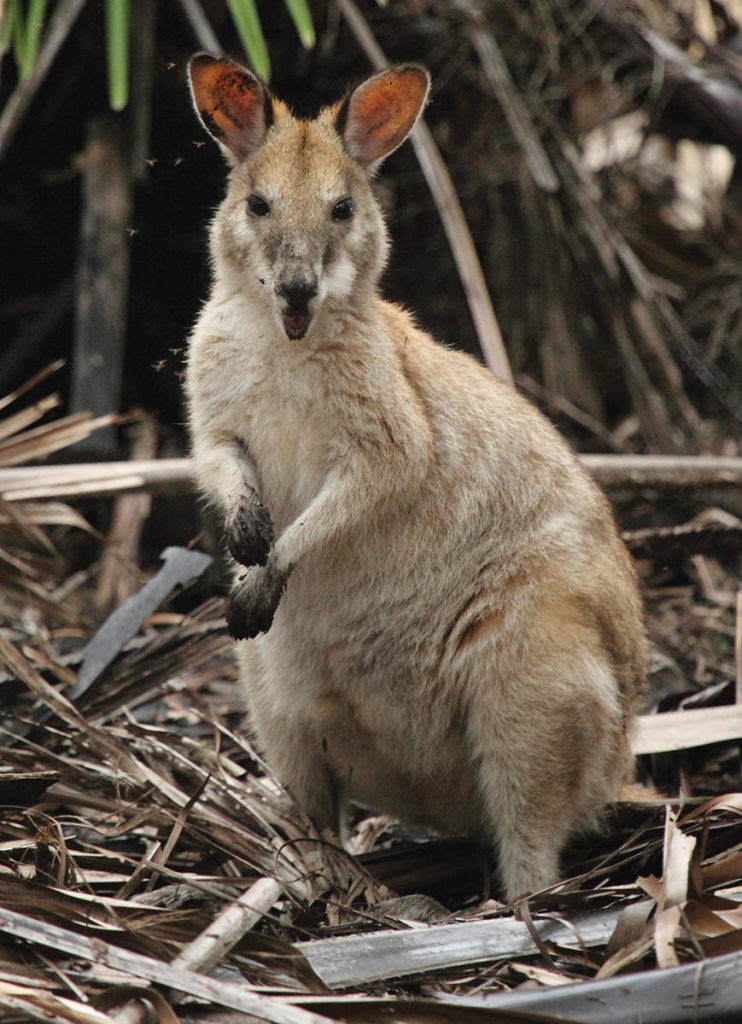
The Agile Wallaby is now restricted to a very limited range in SEQ, occurring only in dry open forest, dunes and heaths around Coomera and Jacobs Well, along with populations on some Moreton Bay islands. They have a varied diet and will graze on grass and foliage, dig up tubers and rhizomes, and forage for fallen fruits. They also regularly search in tidal areas for beach-washed mangrove seeds and seagrass.
Black-striped Wallaby (Macropus dorsalis)
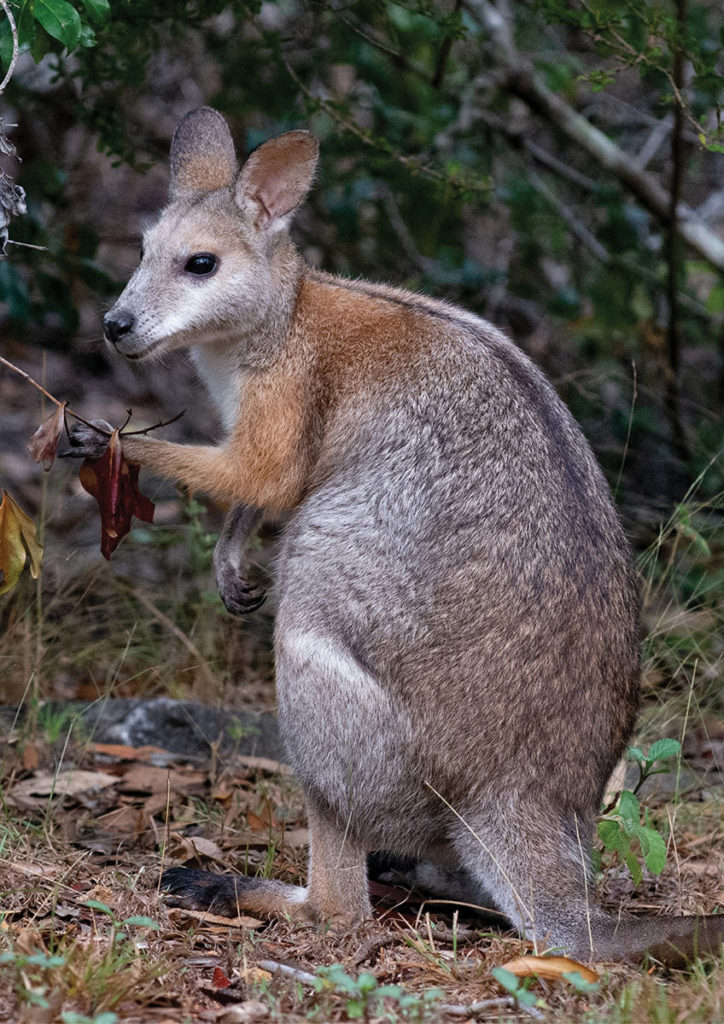
This wallaby prefers dry forest with a dense understorey, such as rainforest margins, brigalow scrubs and open forests with dense wattle or lantana. Not surprisingly, they have a black stripe down their mid-neck and back. The Black-striped and Agile Wallabies are similar in general appearance to the Red-necked Wallaby and care needs to be taken to accurately identify this species.
Red-necked Wallaby (Macropus rufogriseus)
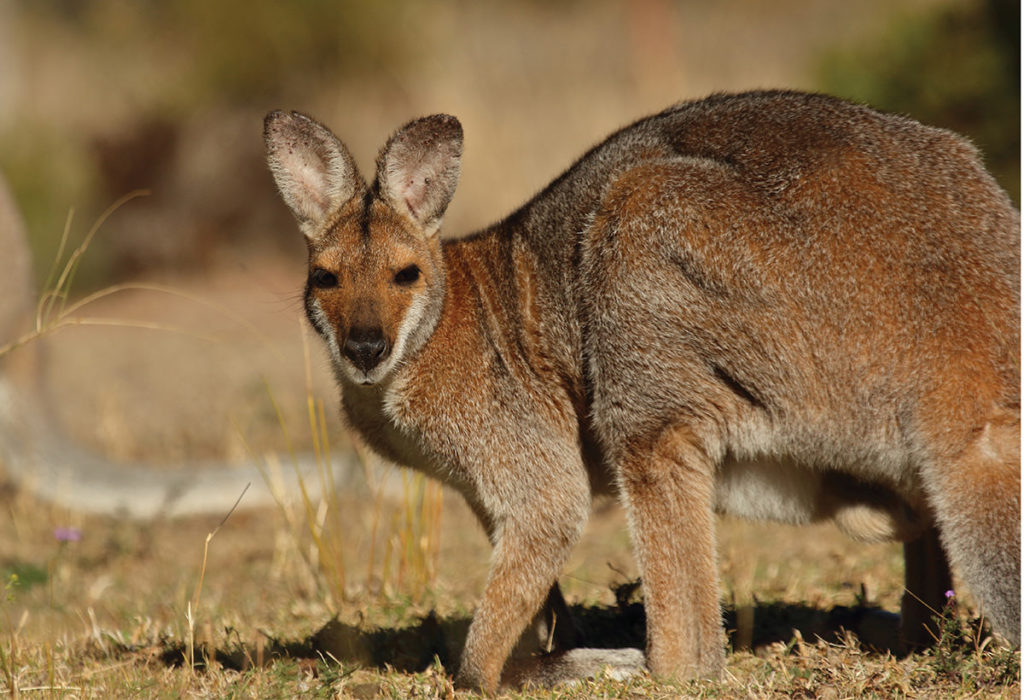
One of the most abundant of the region’s macropods, this largely solitary species inhabits dry, open forests and grasslands as well as nearby open areas such as backyards, paddocks and roadside verges. They spend most of their day resting in the shade before aggregating to feed in the early hours of the morning and at dusk, when they are often seen grazing roadside grasses and herbs. Mothers carry only one young at a time and though breeding can occur all year round, more young are born in summer. Red-necked Wallabies get their common name from the red-tinged fur on their neck and shoulders. They can be distinguished from the other local macropods by their black nose and paws and white stripe on the upper lip.
Whiptail Wallaby (Macropus parryi)
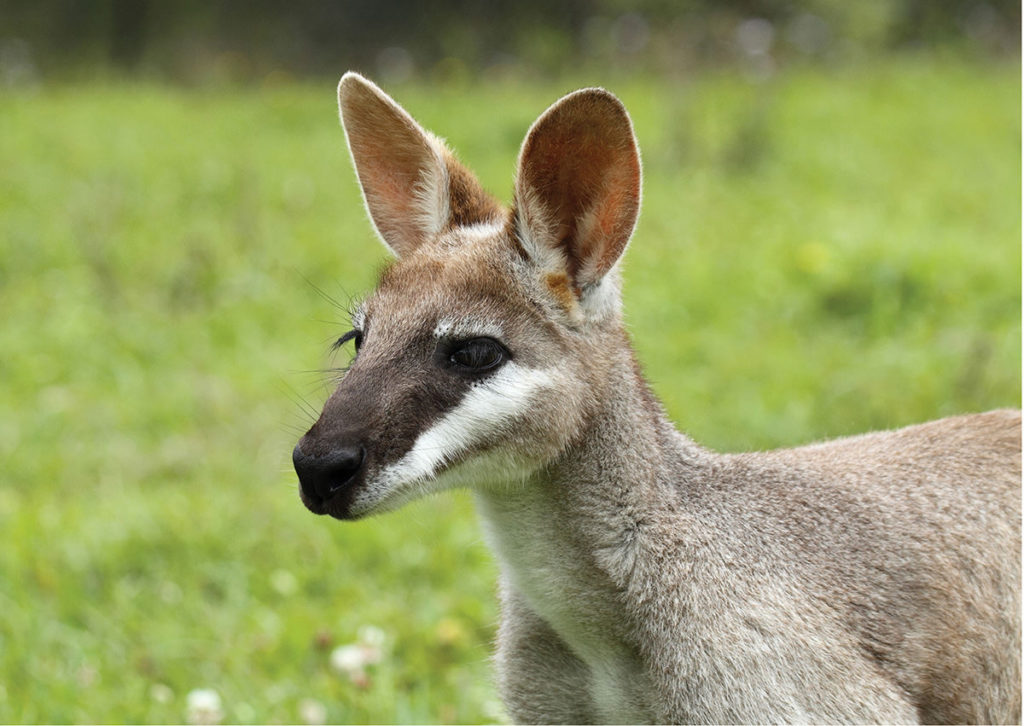
Also known as the Pretty-faced Wallaby, this macropod prefers hilly to steep terrain with open eucalypt forest or woodland and a grassy understory. A social species, they can live in groups of up to 50, comprised of sub-groups of ten or less including both sexes and their young. Females breed throughout the year but peak from October to March. During hot weather, Whiptail Wallabies feed in the early morning and late afternoon, taking cover during the day. However during the winter months they can be seen feeding at all times of the day, grazing primarily on grasses and other herbaceous plants. This species is readily identified by its distinct white cheeks, white ear-tip patches and long thin tail with a dark tip.
Swamp Wallaby (Wallabia bicolor)
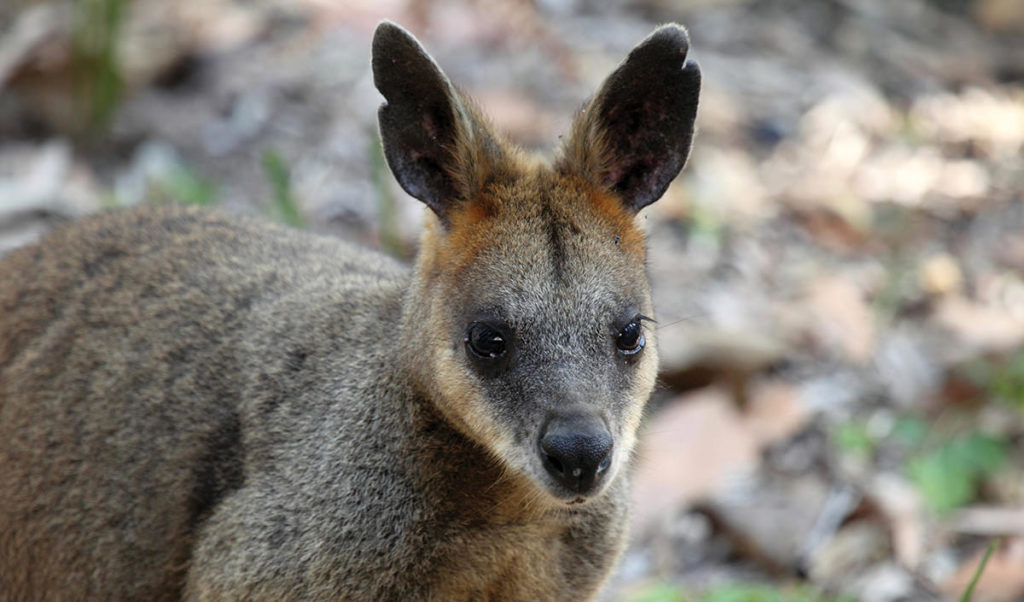
Despite its common name, the Swamp Wallaby makes use of a variety of habitats, such as ferny gullies, shrubby watercourses and open forests and woodlands. They can be found throughout the region where suitable habitats remain, including some surprisingly urban areas of Brisbane. A generally solitary species, they emerge from dense vegetation to feed in open areas and are often seen at dusk and dawn. Swamp Wallabies have dark charcoal fur with an orange belly, yellow face stripe, black fore and hind feet and a white tail tip.
Brush-tailed Rock-wallaby (Petrogale penicillata)
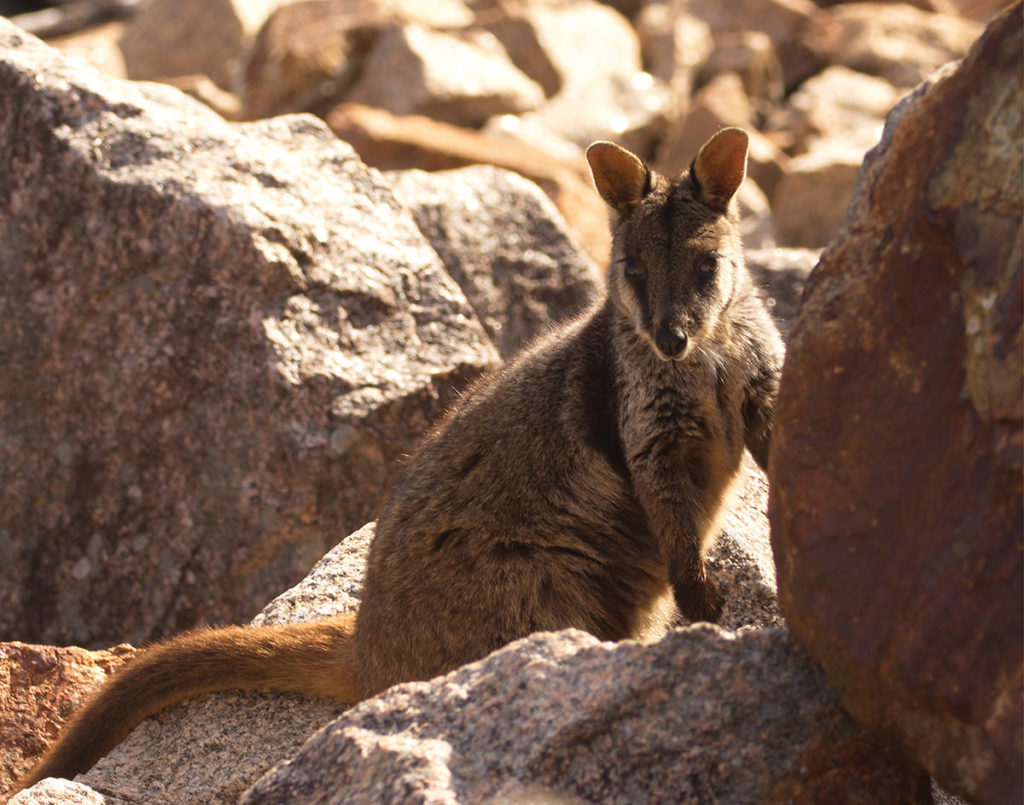
As its name suggests, this wallaby prefers rocky habitats, including boulder piles, cliffs and gorges in dry eucalypt forest. The slopes of Mt Barney and the rocky creek lines around Crow’s Nest are good places to see this species, usually as they bound away, ricocheting from boulder to boulder. They live in small family groups, with a dominant male bonding with up to four females.
Brush-tailed Rock-wallabies feed primarily on grasses and herbs, but will also browse on shrubs, flowers, fruit and seeds. This small, solid wallaby can weigh up to 8kgs and reach a body length of up to 55cm. They have dark grey-brown fur above, with a reddish flush on the rump. Ears, paws and feet are dark brown to black and the tail darkens along its length, ending in a black, brushy tip.
Red-necked Pademelon (Thylogale thetis)
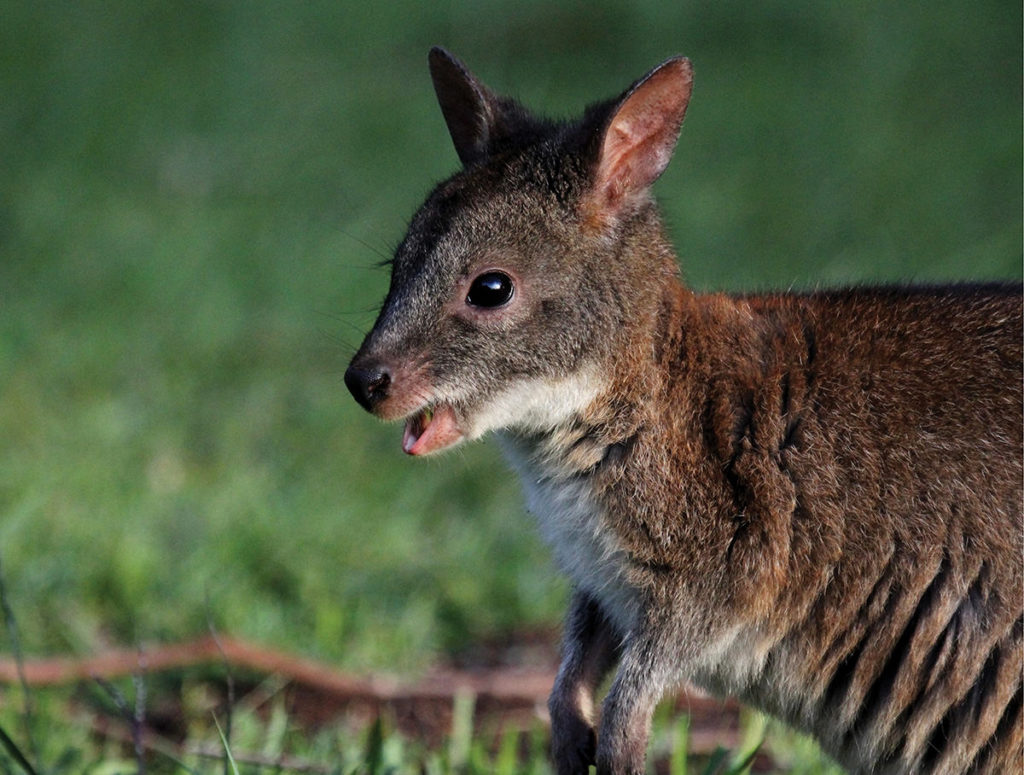
At the other end of the size scale to kangaroos are the pademelons. The Red-necked Pademelon grows to around 60cm tall and weighs up to 6 kilograms. They prefer rainforest and wet sclerophyll forests with dense areas of understory vegetation for shelter, often forming runways in the undergrowth. A shy and mostly nocturnal species, Red-necked Pademelons rarely move far from dense cover, coming out at night to feed on grasses, forbs and shrubs. They are usually solitary but may aggregate together in good foraging areas. This cautious macropod makes loud warning thumps with its hind feet when it senses danger. Breeding takes place throughout the year. They are easily recognised by their small size, brownish-grey colour with distinct reddish neck and shoulders and short tail.
Eastern Grey Kangaroo (Macropus giganteus)
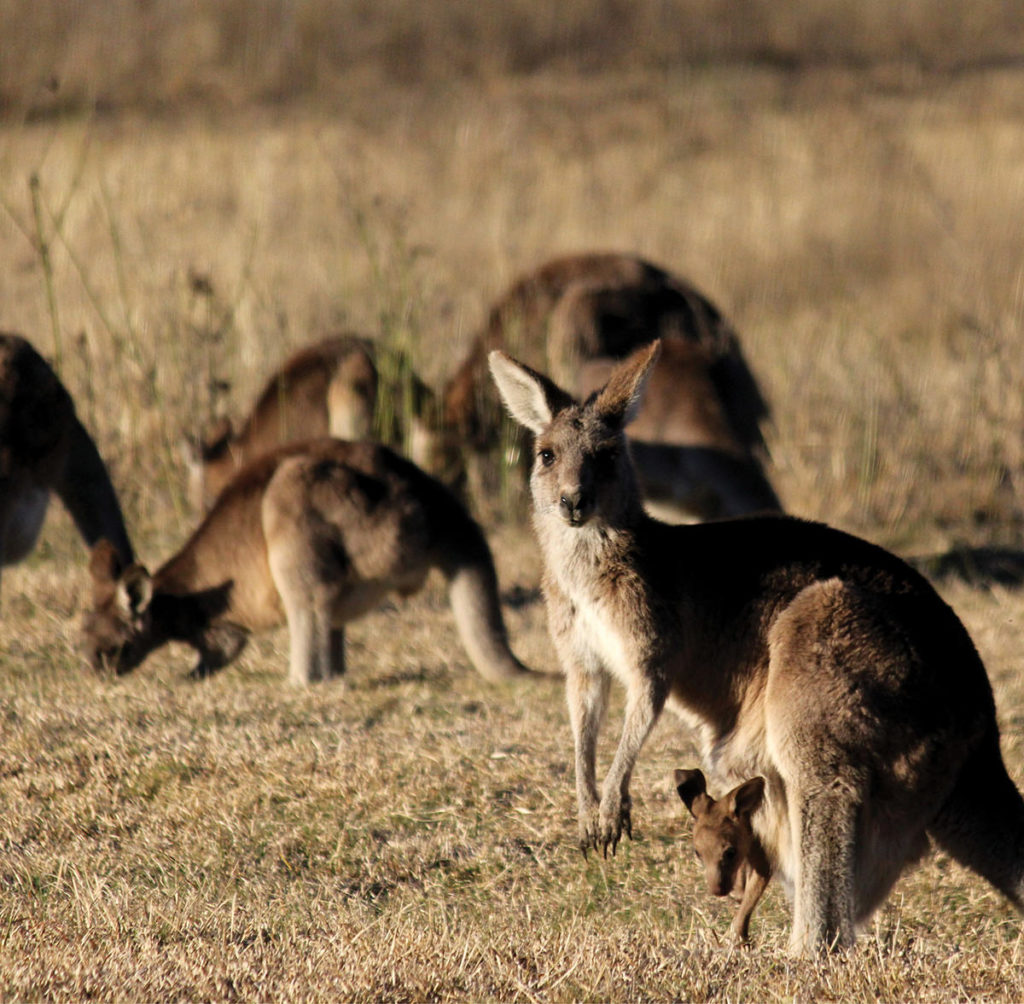
These are SEQ’s largest macropod with males growing as large as 2.3m from head to tail and weighing up to 95 kilograms. Common across eastern Australia, they can be found in woodland, open forest and grasslands, though rural and semi-urban developed areas with lawns, water sources and shady areas also provide ideal living conditions.
These iconic Australian animals are mostly active in the late afternoon and early morning hours when the temperatures are coolest. During the warmest parts of the day they can be found resting under trees and other shady areas. Large mobs will gather at dusk to feed predominately on the young green shoots of grasses. Breeding occurs throughout the year peaking in the summer months. Eastern Grey Kangaroos verbally communicate via a series of clucking sounds. When they are aggressive or alarmed they produce a guttural cough and will thump their tails when they sense danger. Their woolly grey-brown fur is slightly darker on the shoulders and mid-back and the tail has a black tip.
Red-legged Pademelon(Thylogale stigmatica)
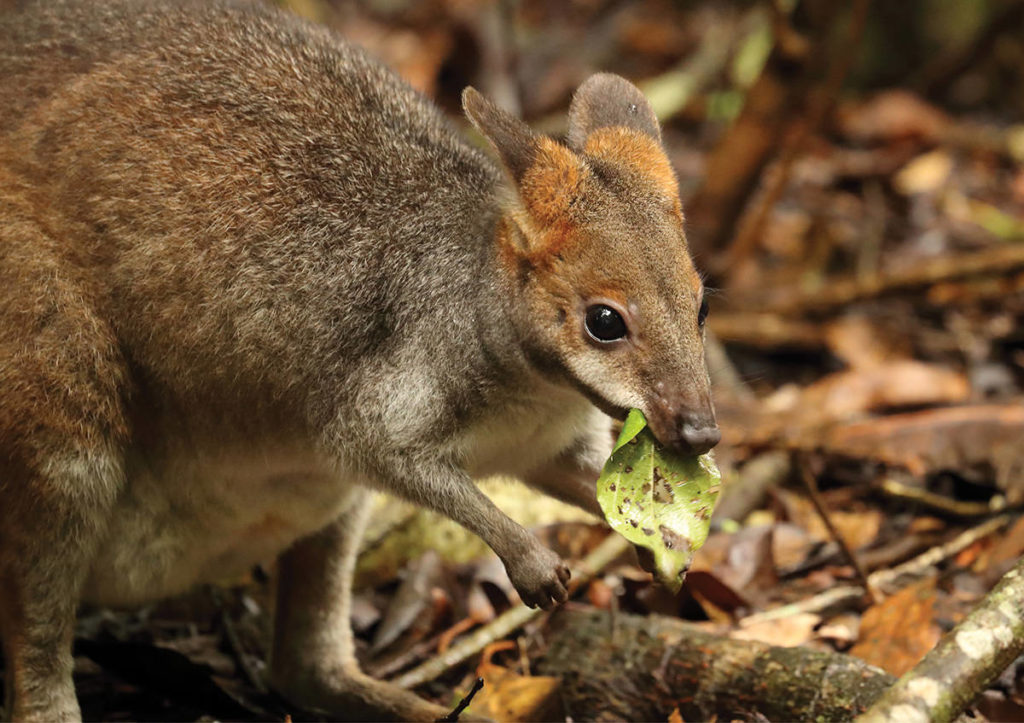
This pademelon is less commonly seen than the Red-necked Pademelon, as it prefers to feed in the dense cover of rainforest habitat. It has bright rusty red fur on its face, legs and the bottom half of the ears, but lacks the red neck of its cousin. The fallen leaves of rainforest trees make up a significant part of their diet.
Article by Peter Hayes
Conservation Partnerships Team Leader
Brisbane City Council
Thanks to Tahlia Clarke for compiling information for this article.

We have a short video of a unusual wallaby ending in our yard in Tallebudgera Valley. We would like to identify it, but have not been able to.
Originally we thought it was a Stradbroke variation of the swampy, but it does not look like it on closer examination. Can anyone assist? Where can we email the video to?
Hi Rob. You could upload the video to a Facebook group like Australian Mammal Identification https://www.facebook.com/groups/MammalIDAus. If you are a member of Land for Wildlife, feel free to email your video to your local Land for Wildlife officer. Cheers.
I often see wallabies that have been killed by road traffic in queensland. I suspect they might be the red necked variety, but have never known how to identify the different species. Do the red necked species have a dark brown, rather thick tail?
I have just done a motorcycle trip from Toowoomba, through Inglewood, Mungindi, Thallon, St George, Miles and then North to Biloela and Monto, and saw several dead wallabies on the way. Would they likely be the Red Necked variety?
Hi Archie. Unfortunately, lots of kangaroos (mostly Eastern Grey Kangaroos), wallabies and even Rufous Bettongs are killed on roads in southern Queensland. The Queensland Museum has a good website to help identify macropods https://www.qm.qld.gov.au/Find+out+about/Animals+of+Queensland/Mammals/Common+mammals+of+south-east+Queensland/Marsupials. Hope this helps.
I have an area of land I am regenerating and am wanting to grow native grasses preferred by kangaroos/wallabies for grazing.
Located on the coast of Wide Bay Burnett region in SE QLD. Soil consists of clay/sand.
Could you possibly recommend native grasses/plants suitable for this?
Thanks.
Hi Andy
You may wish to ask the folk at the Fraser Coast Community native plant nursery https://www.frasercoast.qld.gov.au/fraser-coast-community-nursery.
There are quite a few studies about wild macropod diets that may interest you, such as https://www.publish.csiro.au/WR/WR9830203
Goodluck
Hello,
I am doing a university assignment on the Black-striped Wallaby (Macropus dorsalis) and am wondering if I can use Chris Sanderson’s photo in the assignment. I would reference this site and Chris in my assignment.
Regards
Donna
Hi Donna. We have emailed you a reply directly. Cheers, LfWSEQ Team.
Im wondering is it possible to id
Chocolate coloured wallaby coopers Creek bexhill northern nsw